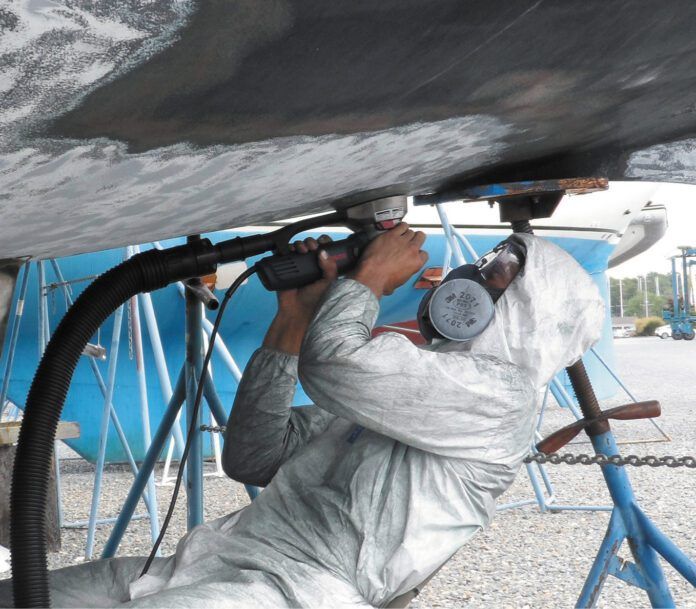More than a century has passed since Art Emmons, a visionary young engineer at the 15-year-old Porter Cable Company, launched a technology race in the field of portable sanders. When he was just 26, Emmons, then Porter Cable’s chief engineer, came up with his “Take About Sander,” which resembled a modern portable belt-sander. It cost the equivalent of $5,000 today, but the value of the powerful handheld sander was obvious to trades people of that era. The pace of innovation in portable tools has hardly slowed since, although most of the improvements involve cordless tools.
After the portable drill, the second most popular power tool that makes its way into a sailor’s toolbox is usually a random orbit sander, also known as an RO Sander. Useful for a range of boat projects from interior woodwork to prepping bottom paint, the random orbit sander’s unique combination of rotation and oscillation makes swirl marks less noticeable. This feature is important for finish sanding, but not so much for prepping for bottom paint, where the sander’s ability to remove layers of paint at high operating speeds comes into play. If you intend to use a sander for more than a quick scuff-job before applying new bottom paint, a plug-in random orbit sander is a worthwhile investment.
OTHER SANDERS
Before we dive into our test of random orbit sanders, a quick review of the similar tools in the handyman sailor’s abrasion arsenal is in order.
Angle grinders. Every do-it-yourselfer should have an angle grinder. The versatile tool can serve multiple functions and is especially good at heavy abrasive work. Equipped with a sanding disk, it can rapidly shape fiberglass and wood. With a flap disk, it can clean metal, smooth welds, and round edges. With a grinding disk, it can shape metal, and with a light touch, sharpen less delicate tools, like lawnmower blades, cold chisels, and paint scrapers.
With a wire wheel it can remove rust, rotten core, and dried adhesives (use a wire brush in a drill when a more delicate touch is needed). Screw-on a cut-off wheel, and it will cut thick and thin steel (not aluminum or brass), plus fiberglass.
Except for some metal hulls, the tool is too aggressive for paint prep. Some models offer dust collection kits, but these only work well when grinding a flat surface, rendering them useless for most boat jobs.
Belt sanders. Just like Emmons’ innovative first portable sander, today’s belt sanders will quickly remove paint on a flat surface. Since most hulls offer very few flat surfaces covering more than a few square feet, belt sanders are of limited use.
Cordless sanders. Cordless sanders are super handy in the shop, and we have nothing against them for small jobs. But for big jobs, their higher weight and limited battery life can be a burden. The one-hour battery life (if you’re lucky) isn’t going to cut it for a long day of bottom sanding. If you are going to be using a dust recovery vacuum (see “Sanding Safety”), you can join the cord and hose using cable ties, so you only have one tentacle to tangle.
Professional grade and dirt-cheap sanders. Having spent many hours with a Mirka sander humming smoothly in our hand, we appreciate the value of professional grade tools. Featuring smoother bearings and rugged motors, a random orbit sander from Mirka, Fein, or Festool can outlast its owner. However, these sanders are three to five times more expensive than brand name, consumer-grade sanders that will meet the needs of most sailors.
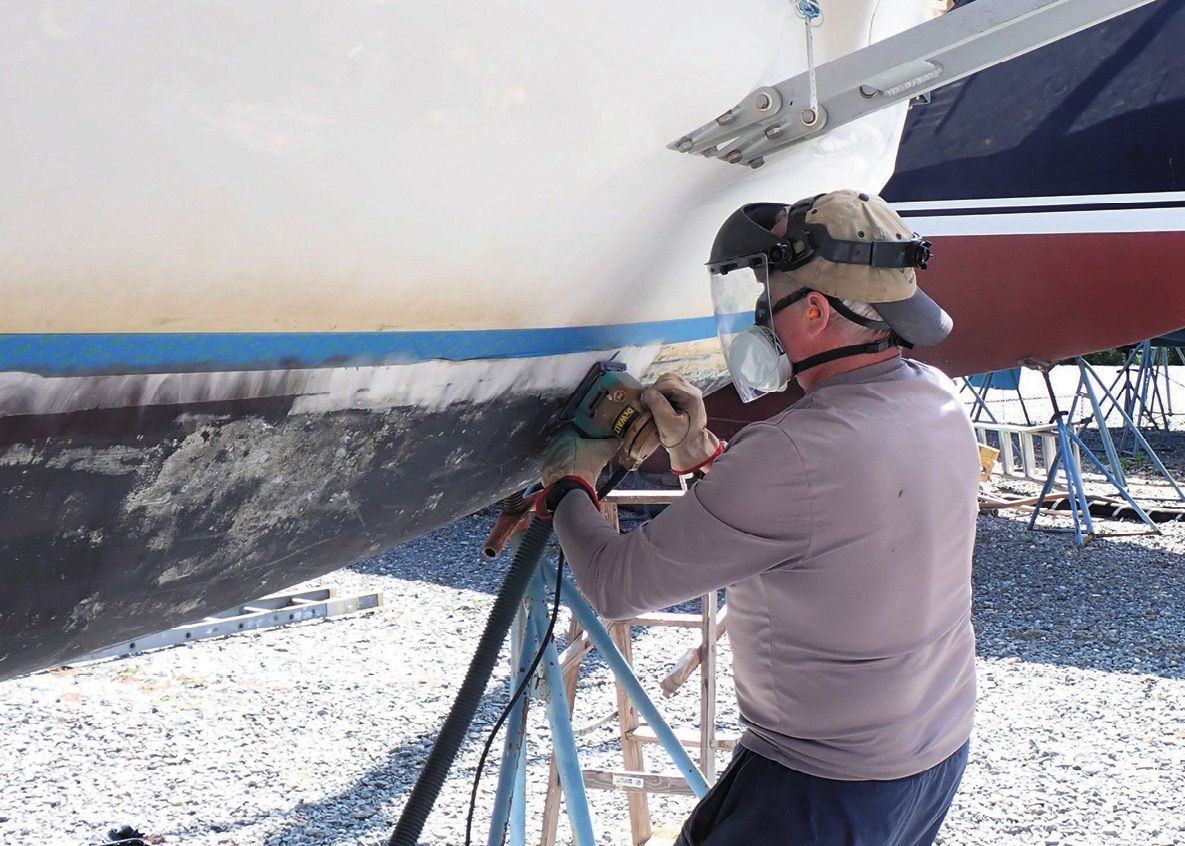
Having used and tested our share of rattling cheap sanders with bearings that barely last a season, we skipped over dozens of no-name sanders with rock-bottom prices. Refinishing the topsides or prepping the bottom are big jobs that will quickly devour a cheap tool.
¼-sheet sanders. ¼-sheet sanders are generally lighter and less expensive than a random orbit sander, and they are extremely durable (ours has lasted 30-plus years). Since you can tear squares from any standard sheet of paper, you will generally pay less for sandpaper.
Using a ¼-sheet sander with coarse grits will leave obvious swirl marks. However, a ¼-sheet sander, also known as a “palm sander,” is a better choice for working in square corners and along the waterline masking tape, because the paper is rectilinear with straight edges.
SANDING SAFETY
We immediately noticed that the newest random orbit sanders have much smoother operation than our old favorites, but we still recommend wearing gloves to help attenuate vibration, which can lead to hand injuries.
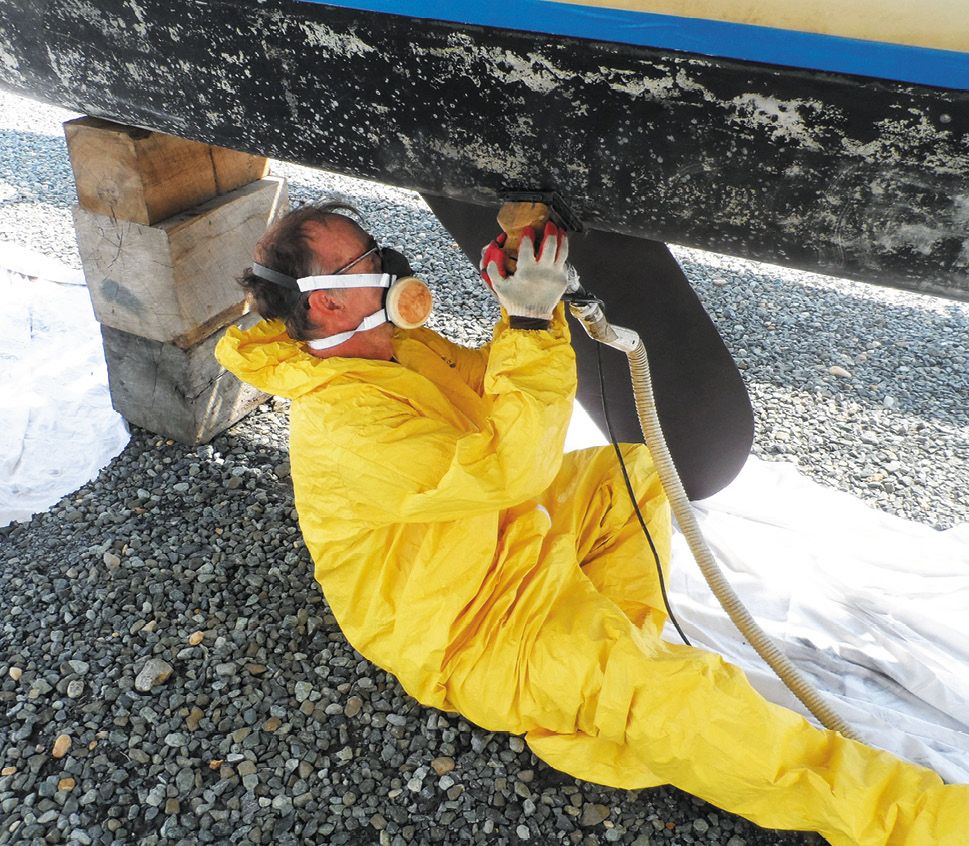
Dust is the main concern. Accumulating on the ground, other boats, your clothes, and, worst of all, in your lungs, dust generated during dry sanding is more than a mere nuisance; it is a health hazard. Using a vacuum recovery system helps reduce dust, but you’ll still need personal protection equipment. We recommend a respirator fitted with an N99 filter when sanding bottom paint (see “The Best Respirators for the Boatyard,” PS September 2017). Although a close-fitting N95 dust mask is adequate for sanding teak outside, bottom paint merits special precautions.
Curiously, in the United Kingdom, most boatyards allow only wet sanding, rendering useless any dust recovery system. In the US it is often the reverse; wet sanding antifouling is strictly prohibited.
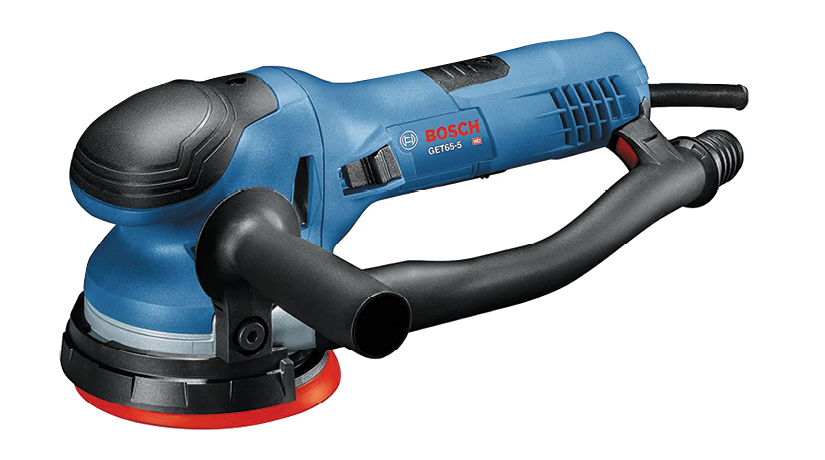
Whichever sander you choose, make sure it has a hose attachment and use it with a vacuum with a HEPA filter. To reduce filter changes on big jobs, you can supplement this system with a pre-filter (see “Another Look at Dustless Sanding,” PS March 2022). Working indoors on a small projects? Our DIY workshop filter-fan will do the trick (see “Making Your Own Workshop Filter,” PS June 2022).
If the paint is loose, or you need to remove several years of built-up antifouling, paint removers are an alternative to sanding (see Inside Practical Sailor blog post, “Digging into Bottom Paint Removal). If the old paint is intact and you are recoating with a compatible paint, you’ll only need to smooth some rough spots and scuff up the rest of the hull.
One way to prevent buildup is to use an ablative paint. In general, you can overcoat a hard paint with a multi-season ablative paint with minimal prep, but applying a hard paint over an ablative paint will usually require more aggressive sanding, and/or a special primer. Whether recoating with the same paint or changing paints, closely follow the manufacturer’s guidance on surface preparation.
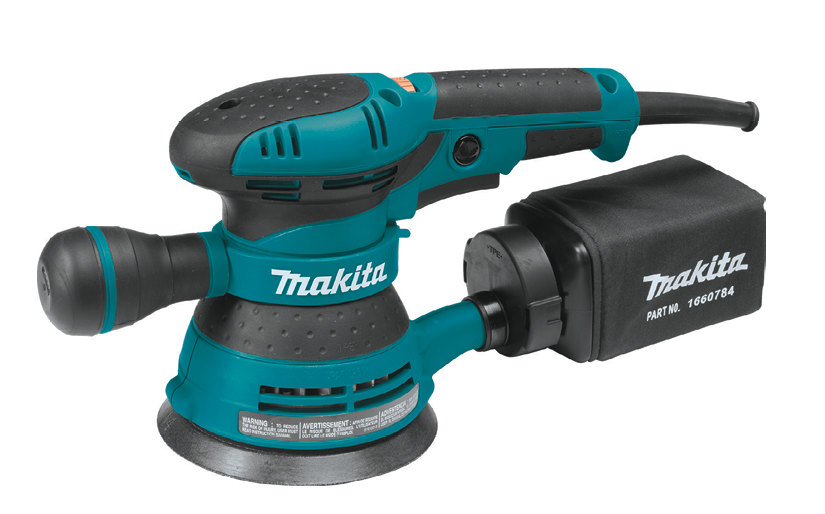
HOW WE TESTED
For this test, we used each sander to prepare a section of our test boat for our ongoing bottom paint test (“Antifouling Paint vs. Chesapeake Bay,” PS December 2023), comparing the most essential features as well as price.
Sandpaper. Most 5-inch random-orbit sanders use the same paper and hole patterns. In our testing, the number of holes did not significantly impact the tool’s ability to remove material. Hook-and-loop disks are preferable for most projects, especially those that require various grits. Stick-on disks are slightly cheaper per sheet. No-hole disks are even cheaper, but useless with vacuum recovery. Foam backing pads are available in a range of densities to suit the project. Some low-grade hook-and-loop papers can slip, leaving swirl marks, so for finer finish opt for high-quality paper.
Fit. Check the handle while wearing work gloves. Is it comfortable in your hands? Are the controls easy to operate?
Weight. Is it light? A few pounds doesn’t seem like much until you hold it over your head for an hour or two.
Disk size. Clearly, a 6-inch sander will complete a job faster than a 5-inch sander. However, unless your boat is very large or has large flat sections, you can’t keep much more than about three inches of the pad in contact with the hull, so a larger size just adds weight.
Velcro pad failure. Although we did not experience this, heat can affect the hook-and-loop’s grip. Lighter pressure and care when working the edges helps prevent the paper from slipping. If the paper or backing pad consistently slips, it’s time to replace the sanding pad.
Price. The portable power tool market is very competitive, so price differences are small between the most popular brands. More expensive, professional grade sanders will last longer, but as long as you avoid online knockoffs, any name brand sander should outlast the average DIY.
WHAT WE TESTED
As our own faithful sanders aged, we decided to check in on the current crop of random orbit sanders, looking specifically at their utility for prepping hull bottoms for painting—a job that often requires long hours of overhead work. Based on input from experienced sailors and boatyard professionals, our small selection is hardly definitive, but it offers a good cross-section of the consumer grade, plug-in sanders available from familiar U.S. brands including Porter Cable, Makita, Milwaukee, Skil, DeWalt, and others. For comparison, we also included our favorite ¼-sheet sander (and its current version) in the mix.
DEWALT DWE6411K ¼-SHEET SANDER
We couldn’t distinguish much difference between this ¼-sheet sander and our much beloved but now discontinued DeWalt DW411, other than a slightly improved grip. This heir apparent to one of our favorite tools should provide years of service. One reason we like DeWalt: The company is credited with introducing an essential feature found in all random orbit sanders today—a kind of clutch that prevents the disc from spinning unless it is pressed against the work surface. Originally, random orbit sanders would spin up to 3,000 rpm the moment you turned them on. Unless you were careful, you could cut an awful scar in the side of your boat with the touch of a button. DeWalt fixed that and they are to be commended.
Bottom line: Recommended.
BOSCH GET75-6N, 6-INCH DUAL MODE SANDER
Bosch’s popular dual-mode random orbit sander is the only six-inch sander in our comparison. It has a slower, lower-friction mode meant for polishing, and another faster mode for sanding. It also has a “turbo” mode that accelerates the disk speed and increases friction so that it is almost as effective as a belt sander for removing surface substrate or several layers of old paint.
According to several independent tests, this mode is three times more aggressive than the standard sander mode and our experience with this machine corroborates this. The six-inch disk makes it heavier than smaller orbit sanders. It can get heavy when working on overhead sections of the hull, but the job goes faster, so you won’t be under the hull nearly as long.
Bottom line: Boatyard workers swear by these sanders. This is our Best Choice for big jobs.
BOSCH GET65-5N, 5-INCH DUAL MODE SANDER
Like its big brother, this random orbit sander-polisher features two modes for fast removal. Despite its smaller diameter head, it won’t shy away from big jobs. A few years ago we watched a sailor use this tool to efficiently strip 15 years of paint off his 36-footer.
Bottom line: Recommended. While the larger model might be faster, this versatile sander is lighter and has a proven track record.
BOSCH ROS20VSC, 5-INCH RO SANDER
According to some reports from users, this basic random orbit sander tends to run hot, but since we always wear gloves to damp the vibration, this wasn’t a factor in our test. While other sanders excelled when paired with vacuum attachments, this sander had the best passive dust collection system in the group.
Bottom line: The passive collection system makes it well suited for ordinary wood working. Recommended.
BOSCH 3725DEVS, 5-INCH RO SANDER
Bosch touts this sander’s ergonomic rear-handle with several different places to grip. The design is supposed prevent hand fatigue by accommodating a variety of grip positions. We found the sander to be noticeably heavier than its siblings and no easier to grip.
Bottom line: This Bosch model is durable and smooth, but it’s too heavy for working overhead.
MAKITA BO5041, 5-INCH RO SANDER
This sander was one of the most comfortable to use, even though it is bulkier than some of the others in the comparison. Operation was smooth and relatively quiet.
Bottom line: This sander is our Best Choice for smaller bottom jobs and bottom prep.
METABO HPT SV13YST, 5-INCH RO SANDER
German-made Metabo grinders (without the HPT designation) have earned a wide following among welders during the past two decades, but the brand is probably unfamiliar to most sailors. Like all other Metabo HPT tools now being sold in North America, this RO sander carried the Hitachi name until 2018 when a U.S. holding company purchased Hitachi’s power tools division. Not to be confused with the more expensive Metabo tools made in Germany, the “Metabo HPT” tools are made in China, as they were under the Hitachi brand.
Bottom line: Time will tell whether the power tools formerly known as Hitachi will be worthy of the Metabo name, but we found it to be a dependable budget sander worth the relatively low price of $55. Recommended.
MILWAUKEE 6034-21, 5-INCH, RO SANDER
While the familiar Milwaukee Tool Company still makes many of its hand tools in the United States and is expanding its US presence, its power tools (many of them made in China) have lost ground to competitors.
Bottom line: We are a big fan of some Milwaukee tools, but the disk on our sander rattled loose, and our research found that the experience was not unique. Not recommended.
SKIL SR 211601, 5-INCH RO SANDER
This basic sander made in China won’t prompt any tool envy from the gearheads, but the Skil brand has earned good reputation for value and durability. One of the company’s greatest claims to fame is that it invented the portable circular saw, a tool many contractors still call a “skilsaw.”
Bottom line: Inexpensive, lightweight and rattle free, this sander should last a long time. It is our Budget Buy.
CONCLUSION
The Bosch GET sanders are powerful beasts, which is why many of the professionals we spoke with swear by them. Fast, comfortable sanders with effective dust collection systems, the GET sanders are definitely worth the expense if you’re planning to remove multiple layers of bottom paint.
For routine bottom jobs, just about any quality finish sander will do the job, either a ¼-sheet sander or a random orbit sander. We expected the random orbit sanders we tested to run circles around our 30-year old DeWalt ¼-sheet sander, but the mighty little DW11 kept up. If all you are doing is a simple scuff-and-paint, there’s no need to run to the tool store.
However, if you’ve got a bunch of sanding projects in your future, and are aiming for a finer, swirl-free finish, an RO sander will soon become your best friend.
CONTACTS
BOSCH, www.boschtools.com
DEWALT, www.dewalt.com
DIABLO, www.diablotools.com
MAKITA, www.makita.com
METABO, www.metabo.com
MILWAUKEE, www.milwaukeetool.com
In search of an alternative to conventional sandpaper, we tested various metal screens against conventional sandpapers.
Our first contender, recommended by several PS readers, were generic drywall screens, which we fitted to a DeWalt DW411 ¼-sheet sander. We found that the grit in most drywall screens (typically 150 grit) is not coarse enough. The screens tended to clog with bottom paint, interfering with dust collection.
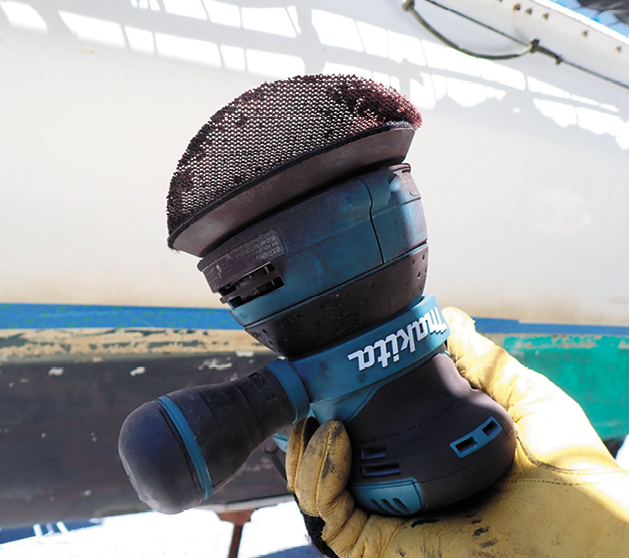
We got better results with Diablo SandNet sanding screens, which we tested on the Makita BO5041 random orbit sander. Although the 60-grit Diablo screens feel slightly less aggressive than conventional sandpaper of the same grit, they removed paint just as well. The screen design slightly improved dust collection, fouled less, and lasted about 50 percent longer. Each pack comes with a breathable pad that allows the vacuum to pull across the entire surface.
Fein makes a sanding fleece designed especially for removing antifouling paint (part no. 63732004010). The fleece, which resembles a Scotch-Brite pad, is designed to run at about 750 rpm on a special rotary polisher equipped with an efficient dust collection system. The fleece is more durable than sandpaper, but better suited to burnishing a hull for a racing finish than it is for removing paint. The pads are compatible with the Bosch GET75-6N and other six-inch sanders.
Scotch-Brite Pads with a hook-and-loop Hookit backing pad are an option for those who just need to scuff up a good finish for repainting. The pads are also useful for reactivating a hard paint that has been in storage, or an epoxy-copper paint that is losing its punch after a haulout (see the Inside Practical Sailor blog post, “Hard Paints and Haulouts”). For reactivating good paint, use a fine or ultra-fine pad and apply only light pressure.
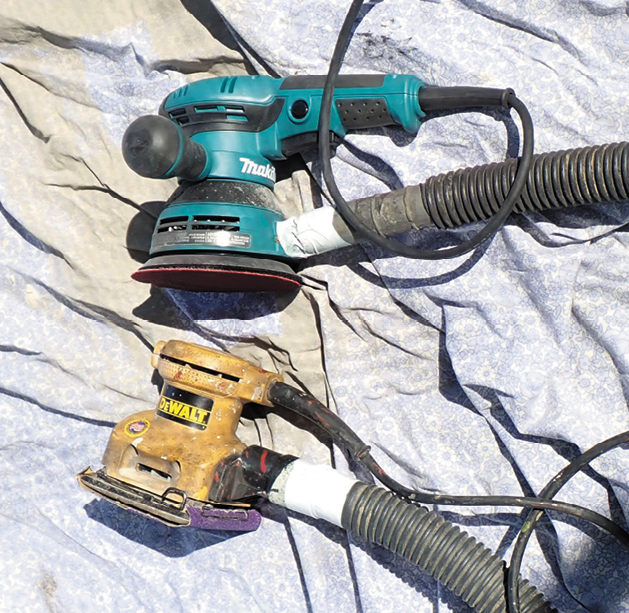
Some say 150 grit is the right grit for prepping bottom paint prep. That might work for a freshly painted boat, but we found that 60 – 80 grit removes old paint twice as fast, with less fouling, dust, and effort. We also believe the more aggressive profile will promote better adhesion to the old paint.
Our local yard swears by 60-grit Bosch SR6 ROOO paper for their GET75-6N sanders. At some yards, 36-grit paper is the standard—which is far too coarse for a basic bottom job in our view. Coarser grits are clearly a bad idea for boats that have recently been refinished with an expensive epoxy barrier coat and have not yet built up several layers of paint (see “Bottom Paint Makeover,” PS October 2015). If you’re worried about burning through your new barrier coat by accident, start at 100 grit and see how that goes.
TEST REPORT: RANDOM ORBIT SANDERS COMPARED
| ANUFACTURER | MODEL | TYPE | HEIGHT | LENGTH | DISK SIZE | ORBITS PER MINUTE | AMPS | WEIGHT | PRICE |
|---|---|---|---|---|---|---|---|---|---|
| BOSCH | GET75-6N | Random orbit (dual mode) | 5.5 in. | 15 in. | 6 in. | 3300-7300 | 7.5 amps | 5.7 lbs. | $325 |
| BOSCH | GET65-5N | Random orbit (dual mode) | 5.8 in. | 13 in. | 5 in. | 3300-7300 | 6.5 amps | 5.3 lbs. | $310 |
| BOSCH | ROS20VSC | Random orbit | 6 in. | 9 in. | 5 in. | 12500 | 2.5 amps | 3.5 lbs. | $70 |
| BOSCH | 3725DEVS | Random orbit | 5.25 in. | 12 in. | 5 in. | 4500-12000 | 3.3 amps | 5.1 lbs. | $185 |
| DEWALT | DWE6421 | Random orbit | 6 in. | 10.4 in. | 5 in. | 12000 | 3 amps | 2.9 lbs. | $95 |
| DEWALT | DW411 | Quarter sheet | 5 in. | 10 in. | 4 x 5 in. | 13500 | 1.7 amps | 2.6 lbs. | $65 |
| DEWALT | DWE6411K | Quarter sheet | 5 in. | 10 in. | 4 x 5 in. | 14000 | 2.3 amps | 2.4 lbs. | $64 |
| MILWAUKEE | 6034-21 | Random orbit | 7 in. | 9 in. | 5 in. | 7000-12000 | 3 amps | 3.1 lbs. | $89 |
| MAKITA | BO5041 | Random orbit | 6 in. | 10 in. | 5 in. | 4000-12000 | 3 amps | 2.2 lbs. | $115 |
| METABO | SV13YST | Random orbit | 6 in. | 8 in. | 5 in. | 13000 | 2.8 amps | 3.1 lbs. | $54 |
| SKILL | SR 211601 | Random orbit | 5.5 in. | 8 in. | 5 in. | 7000-13000 | 2.8 amps | 3.4 lbs. | $50 |
































